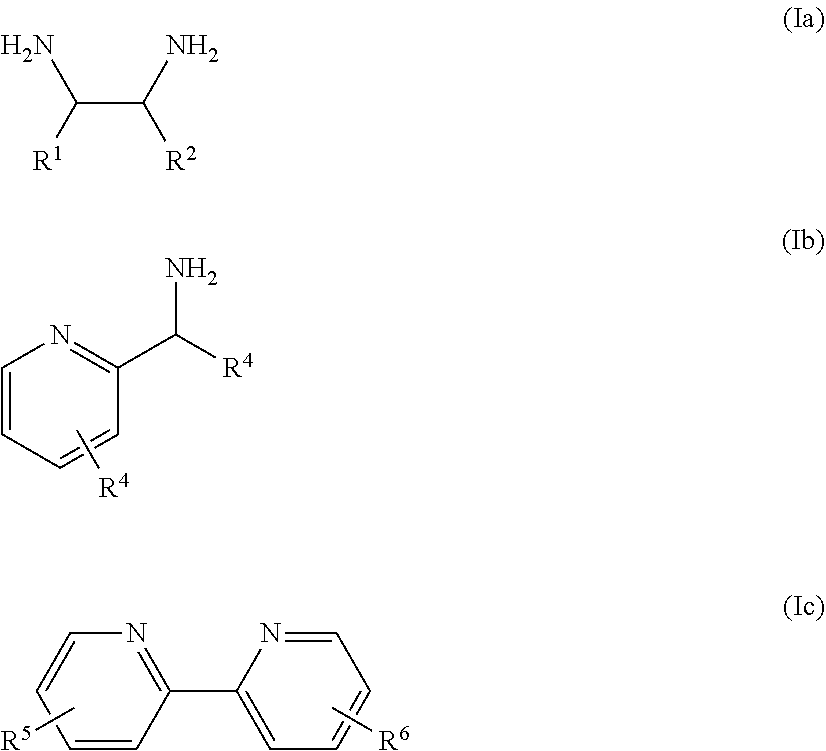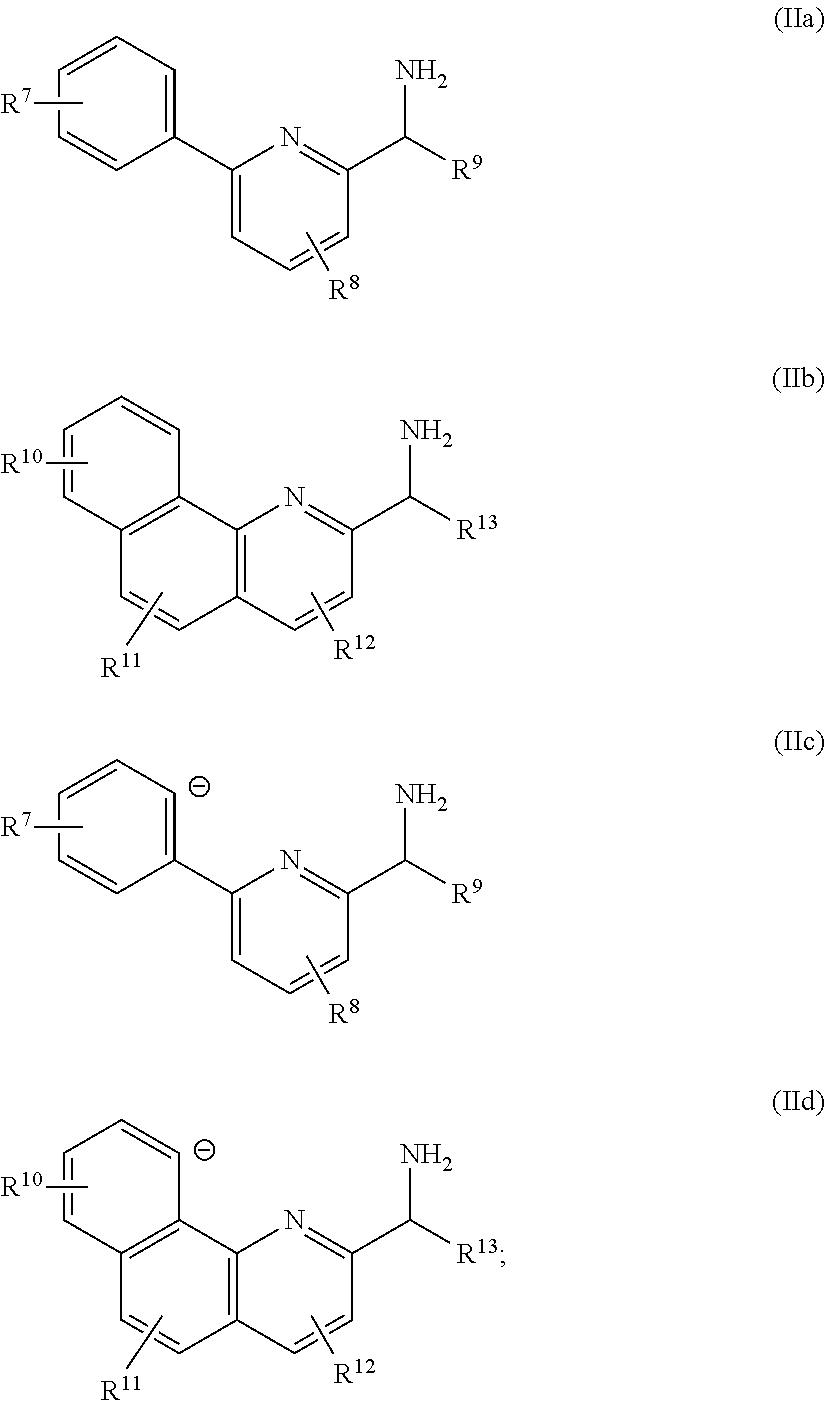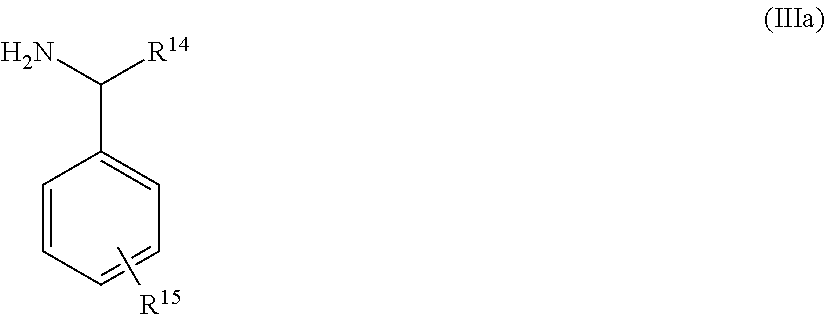Monocarbonyl ruthenium and osmium catalysts
a technology of monocarbonyl ruthenium and osmium catalyst, which is applied in the direction of physical/chemical process catalyst, organic compound/hydride/coordination complex catalyst, organic compound/chemical process catalyst, etc., can solve the problem of crucial problem of catalyst development with high chemo- and stereoselectivity
- Summary
- Abstract
- Description
- Claims
- Application Information
AI Technical Summary
Benefits of technology
Problems solved by technology
Method used
Image
Examples
example 6
of the Complex [RuCl(CO)(en)(dppb)]Cl (8)
[0315]The complex [RuCl2(CO)2]n (50 mg, 0.22 mmol, 1 equiv) suspended in 5 mL of distilled isopropanol, was reacted with the ligand dppb (94 mg, 0.22 mmol, 1 equiv). After stirring the mixture for 2 hours at 90° C., the ligand en (15 μL, 0.22 mmol, 1 equiv) was added and stirred for further 2 hours at 90° C. The solution was evaporated in vacuum, and the solid was dissolved in CHCl3 (3 mL) and stirred for 3 hours at room temperature. The volume was reduced by half, the complex was precipitated by adding 5 mL of pentane. The obtained solid was filtered, washed 2 times with 10 mL of ethyl ether and dried at reduced pressure. Yield: 151 mg (98%). Anal. Calcd (%) for C32H36ClN2O2P2Ru:C, 56.60; H, 5.34; N, 4.13, Found: C, 56.59; H, 5.39; N, 4.20. 1H NMR (200 MHz, CDCl3) δ 7.84-7.65 (m, 4H), 7.56-7.29 (m, 16H), 3.68-3.37 (m, 2H), 3.05-2.74 (m, 4H), 2.65-2.35 (m, 4H), 2.18-1.87 (m, 2H), 1.76-1.52 (m, 4H). 13C NMR (50 MHz, CD2Cl2) δ 199.5 (t, J=13.6 ...
example 7
of the Complex [RuCl(CO)(en)(dppf)]Cl (9)
[0316]The complex RuCl2(CO)(dmf)(PPh3)2 (200 mg, 0.25 mmol, 1 equiv) dissolved in CH2Cl2 (2 mL) was reacted with the ligand dppf (160 mg, 0.29 mmol, 1.2 equiv) at room temperature for 2 h. The ligand en (15 μL, 0.37 mmol, 1.5 equiv) was then added and the mixture was stirred at room temperature for 2 h. The solution was concentrated to about 0.5 mL and the complex was precipitated by addition of n-heptane (10 mL). The obtained solid was filtered and thoroughly washed 4 times with ethyl ether (3 mL) and dried under reduced pressure. Yield: 180 mg (88%). Anal. Calcd (%) for C37H36Cl2FeN2OP2Ru:C, 54.56; H, 4.46; N, 3.44, Found: C, 54.50; H, 4.51; N, 3.47. 1H NMR (200 MHz, CD2Cl2) δ 7.97-7.24 (m, 20H), 5.59 (s, 2H), 5.15-4.91 (m, 2H), 4.53 (s, 2H), 4.20 (s, 2H), 3.97 (s, 2H), 3.68-3.42 (m, 2H), 2.58-2.41 (m, 2H), 2.14-1.85 (m, 2H). 13C NMR (50 MHz, CD2Cl2) δ 204.0 (t, J=14.8 Hz), 135.9 (t, J=5.7 Hz), 134.2, 134.1 (d, J=10.1 Hz), 133.4, 132.9 (t, ...
example 8
of the Complex [Ru(OAc)(CO)(en)(dppb)]OAc (10)
[0317]The complex Ru(OAc)2(CO)(PPh3)2 (200 mg, 0.26 mmol, 1 equiv) suspended in CH2Cl2 (2 mL) was reacted with the ligand dppb (120 mg, 0.29 mmol, 1.1 equiv) at room temperature for 6 h. The ligand en (25 μL, 0.37 mmol, 1.4 equiv) was added and the solution was stirred at room temperature for further 2 h. The solution was concentrated to about 0.5 mL and the complex was precipitated by addition of n-heptane (10 mL). The obtained solid was filtered and washed 4 times with ethyl ether (3 mL) and dried under reduced pressure. Yield: 182 mg (97%). Anal. Calcd (%) for C35H42N2O5P2Ru:C, 57.29; H, 5.77; N, 3.82 Found: C, 57.70; H, 5.90; N, 3.50. 1H NMR (200 MHz, CD3OD) δ 7.64-7.30 (m, 21H), 4.76-4.62 (m, 1H), 4.30-4.14 (m, 1H), 4.10-3.92 (m, 1H), 2.92-2.47 (m, 6H), 1.86 (s, 3H), 1.58 (s, 3H), 1.31-1.18 (m, 2H). 13C NMR (50 MHz, CD3OD) δ 203.8 (t, J=17.7 Hz), 182.7, 182.5, 134.8 (d, J=10.5 Hz), 134.4-134.1 (m), 133.8-133.6 (m), 132.3, 131.7, 131...
PUM
| Property | Measurement | Unit |
|---|---|---|
| room temperature | aaaaa | aaaaa |
| volume | aaaaa | aaaaa |
| volume | aaaaa | aaaaa |
Abstract
Description
Claims
Application Information
 Login to View More
Login to View More - R&D
- Intellectual Property
- Life Sciences
- Materials
- Tech Scout
- Unparalleled Data Quality
- Higher Quality Content
- 60% Fewer Hallucinations
Browse by: Latest US Patents, China's latest patents, Technical Efficacy Thesaurus, Application Domain, Technology Topic, Popular Technical Reports.
© 2025 PatSnap. All rights reserved.Legal|Privacy policy|Modern Slavery Act Transparency Statement|Sitemap|About US| Contact US: help@patsnap.com



